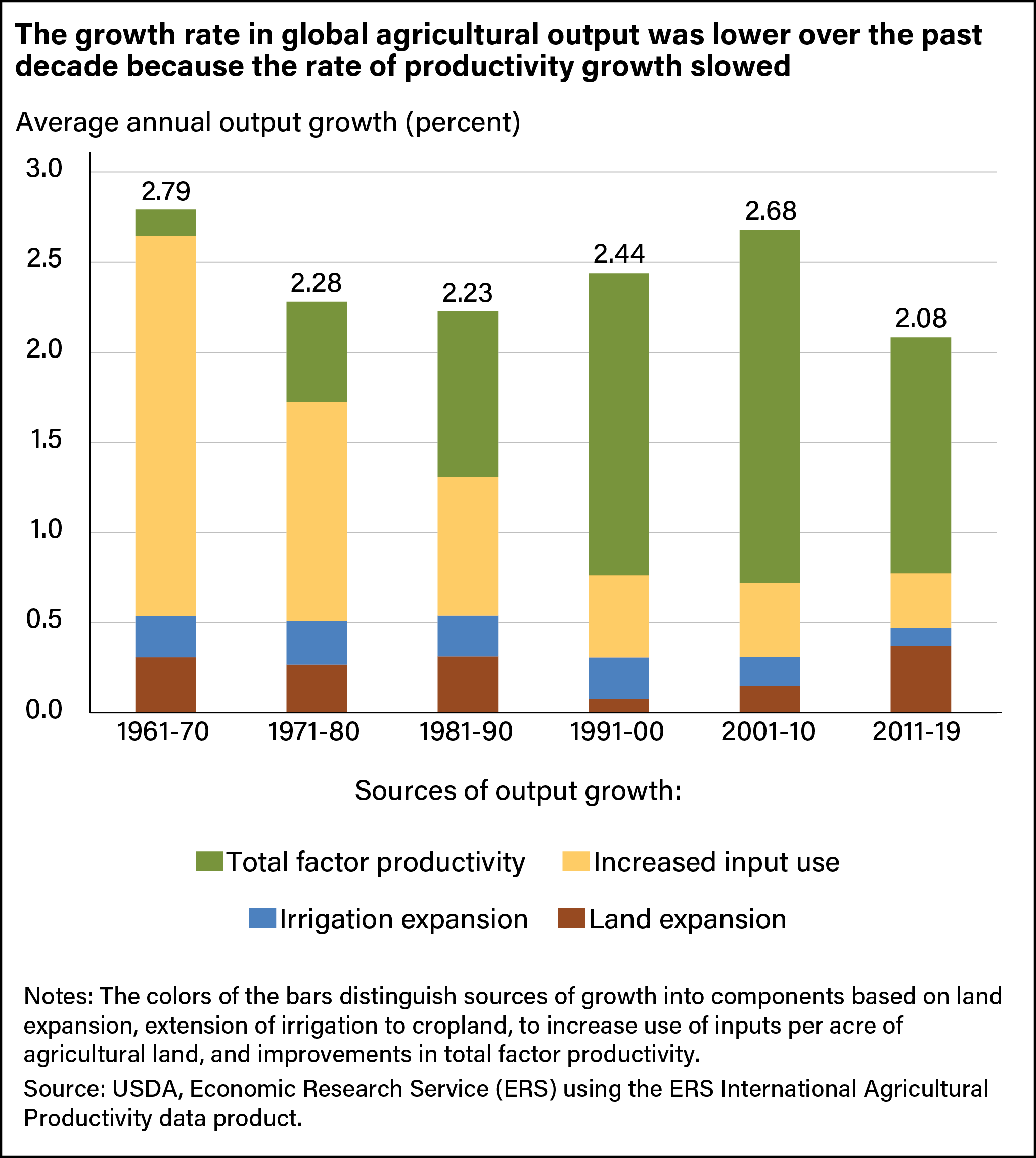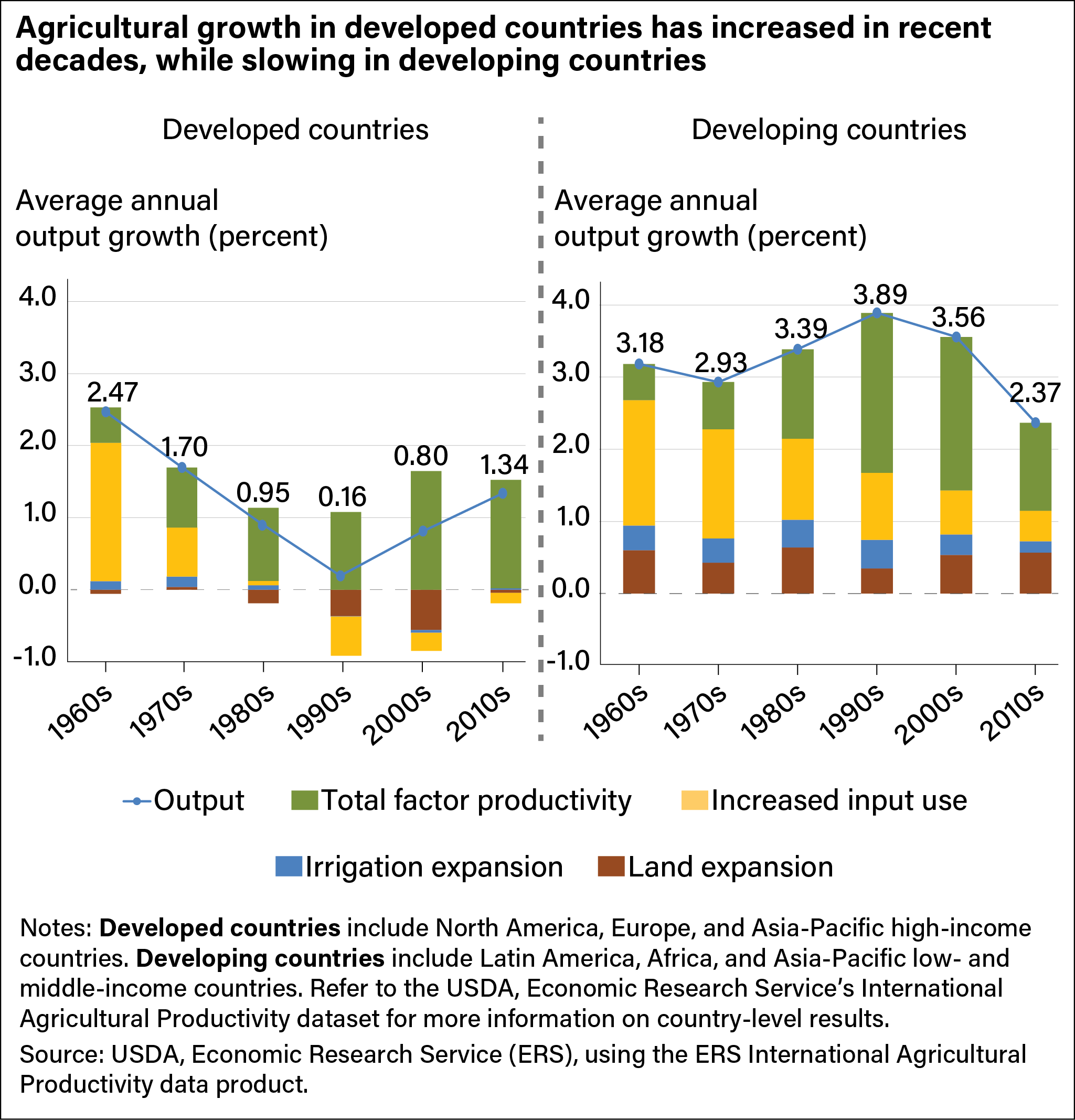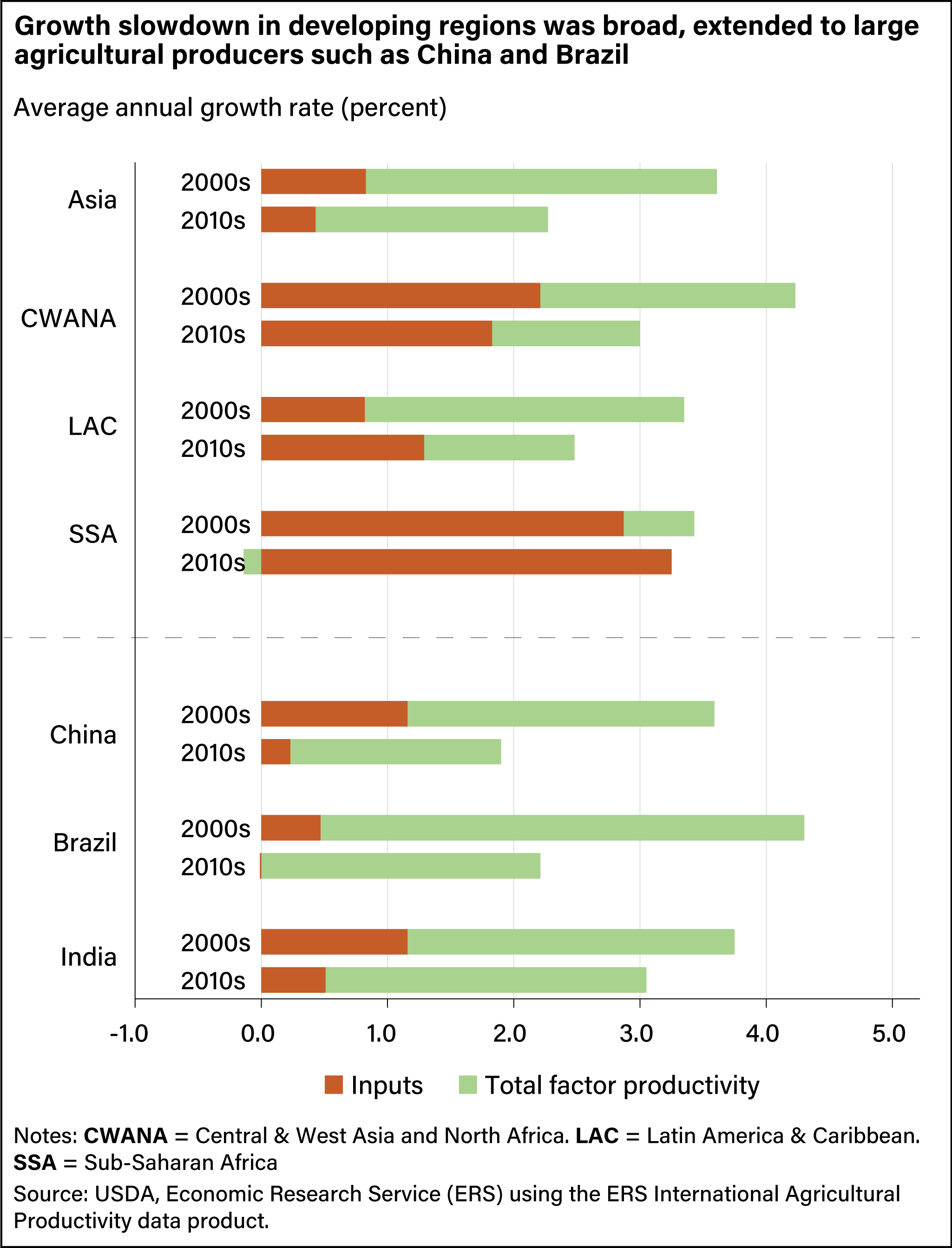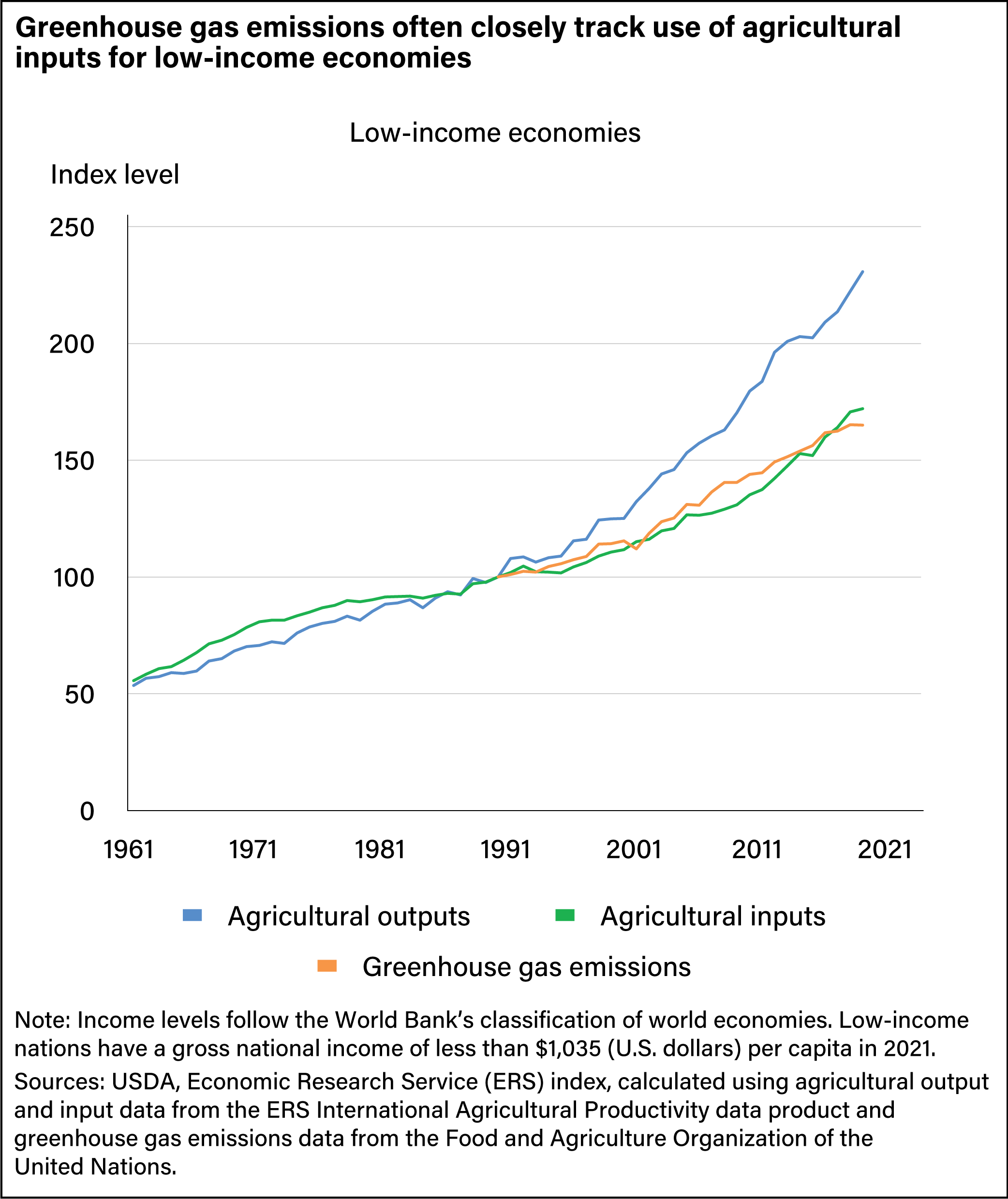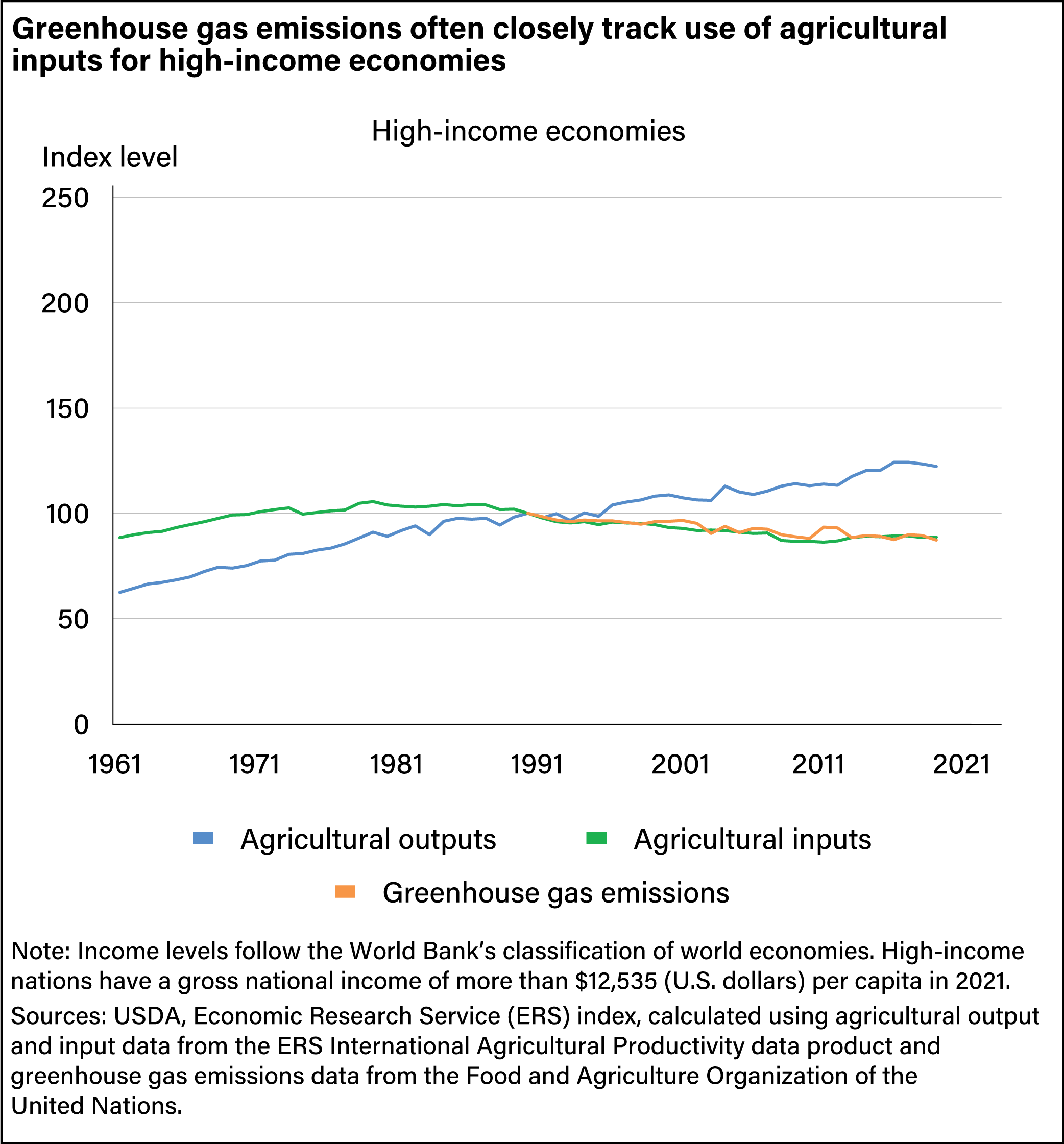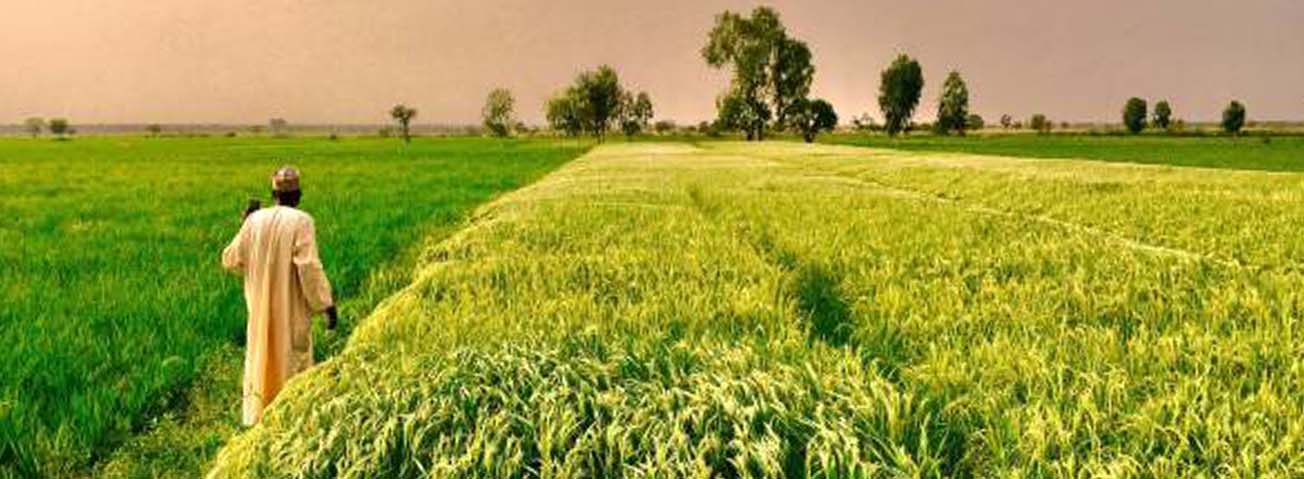
Slowing Productivity Reduces Growth in Global Agricultural Output
- by Keith Fuglie, Jeremy Jelliffe and Stephen Morgan
- 12/28/2021
Highlights
- Data collected and analyzed for 2011–19 by USDA’s Economic Research Service revealed that reduction in the growth of global agricultural output is strongly linked with a recent slowdown in agricultural productivity.
- Total factor productivity, which measures the overall efficiency with which inputs are combined to produce output, grew at a global annual rate of 1.31 percent in the 2010s, down from 1.96 percent per year in the 2000s.
- The slowdown in agricultural output growth is observed primarily in developing countries, with Asian countries leading the slowdown in output growth.
- Declining productivity growth could result in consequences such as higher food prices and increased greenhouse gas emissions from agriculture.
Increasing agricultural productivity is key to ensuring an abundant and affordable food supply for a growing global population while still conserving limited environmental resources such as land. A main driver of productivity growth is the development, adoption, and diffusion of new agricultural technologies and management practices. With technological progress and innovation, not only have agricultural yields increased, but opportunities to better manage the land, labor, and capital (inputs) needed for production and reduce the environmental impact of production also have emerged. The benefits of new agricultural technologies, practices, and knowledge have been widespread across farms of different sizes, income levels, and agro-ecological environments.
In recent years, however, growth in agricultural productivity has slowed, meaning the relative rate of output to input growth has narrowed. An update to the USDA, Economic Research Service (ERS) International Agricultural Productivity data product links deceleration in the growth of agricultural output with a recent slowdown in agricultural productivity. From 2011–19, the volume of world agricultural output was 6 percent below what it would have been if the growth rate of the previous decade had been maintained and compounded over time.
Slowing Growth in Agricultural Total Factor Productivity
Total factor productivity (TFP) is a broad measure of agricultural productivity that compares total output of crop and animal commodities to the total set of land, labor, capital, and material inputs used in farm production (see blue box below). TFP measures the overall efficiency with which inputs are combined to produce output. When total output is increasing faster than total inputs, TFP is said to be growing.
After the “Green Revolution” of the 1960s and 1970s increased crop yields, growth rates in agricultural output peaked and then started declining until the 1990s. In the 1990s and 2000s, growth rates in global agricultural output began trending upward again. Driven by more rapid TFP growth, world agricultural output increased fast enough to meet food demand from growing global populations and incomes, and reduced the need to use more land, labor, and other resources. However, ERS data indicate that global agricultural productivity growth slowed in the 2010s. Output grew at an average annual rate of 2.08 percent during 2011–19 compared with 2.68 percent during 2001–10 (see chart below). Average TFP growth during these decades fell from 1.96 percent annually to 1.31 percent annually. While growth in output from an increased use of labor, capital, and material inputs per acre as well as irrigation also declined, these changes were small compared with the slowing of TFP growth. At the same time, the rate at which agricultural land was expanding increased.
Where Has Agricultural Productivity Been Slowing?
The slowdown in agricultural output growth over the past decade occurred primarily in developing countries (see right side of chart below). The growth rate in agricultural production in developing countries declined from an average of 3.56 percent in the 2000s to 2.37 percent in the 2010s. A decrease in the rate of TFP growth was responsible for most of this decline. Developed countries (left side of chart below) experienced stable or increasing average output growth. Here, productivity growth remained strong in the 2010s while the level of inputs used in the agricultural sector stabilized. In the 1990s and 2000s, agricultural inputs (especially labor and land) in developed countries were being redirected to other sectors such as manufacturing and services.
For developing countries, the productivity slowdown was widespread across most regions. Comparing average growth rates in the 2010s with the previous decade reveals Asia experienced the largest slowdown in output growth, followed by the Central and West Asia-North Africa region. In terms of productivity growth, Latin America and the Caribbean experienced the largest slowdown, followed by Asia. In Sub-Saharan Africa, agricultural productivity growth was already low in the 2000s and turned slightly negative in the 2010s.
These patterns extend to major agricultural producers and exporters. Brazil, China, and India all experienced slowing output and productivity growth. The largest declines were experienced by Brazil, where average annual output growth in 2011–19 fell by 2.1 percentage points compared with the previous decade.
What Are Some Implications of Slowing Agricultural Productivity Growth?
Higher productivity allows farmers to produce commodities with fewer resources, which can lower unit costs and reduce agricultural prices. Past performance suggests slowing growth in agricultural productivity may lead to higher prices in global commodity markets. Higher food prices are especially costly to low-income households, who already spend a large share of their income on food. Historical improvement in agricultural productivity led to declines in inflation-adjusted commodity prices of an average of 1 percent a year from 1900 through 2000 even as world population tripled (see chart below). Since the turn of the millennium, however, agricultural prices have trended higher, driven by multiple forces including increased food and biofuel demand, rising input prices (such as for fertilizer) and slowing productivity.
When productivity growth declines, agricultural producers will need more inputs and environmental resources that could have been used in other sectors or for other purposes to ensure growth in output. Such a reallocation of resources often has consequences. First, shifting more land, labor, and capital to the farm sector from other economic uses could slow growth in other sectors, including manufacturing and services, that are important to both rural and broader national economies. Second, increasing agricultural land use and input intensification means a larger environmental footprint of agriculture, including higher greenhouse gas emissions from agriculture. As illustrated in the chart below, greenhouse gas emissions from agriculture closely track aggregate input use. Countries where TFP improvement has enabled fewer inputs to be used in farm production have been able to curb the growth of, or even reduce, greenhouse gas emissions from agriculture. Countries where input use is still rising are seeing rapid growth in emissions.
Causes and Consequences
Several factors may be affecting the global slowdown in agricultural productivity growth. Weather shocks associated with a changing climate (such as drought, heat, or flooding) can decrease yields. These effects would be cumulative as further increases in temperature or adverse weather shocks result in larger and more frequent reductions in productivity over time. In addition to lowering overall productivity, climate change may shift global production patterns. In other words, crops that used to be grown productively in one region may no longer be suitable to new agro-ecological conditions, such as changes in seasonality, temperature, and precipitation, and might be more suited to other regions.
The emergence of new or resistant forms of crop diseases and pests—such as citrus greening, fall armyworm, and herbicide-resistant “super” weeds— also are worth watching as productivity gains slow. These new threats to yields may require the use of additional inputs such as labor and chemicals to control their spread. Long-term solutions may involve new research and development to provide technology-based solutions that are adaptable to specific production environments.
Slow diffusion of improved agricultural technologies among producers remains a central issue in determining TFP growth. This is a challenge among producers in developing countries, where underdeveloped agricultural extension systems, limited access to financial and insurance services, and insecurity of land tenure may contribute to weak incentives for producers to invest in new technologies. Among developed countries, agricultural policies and public attitudes toward new technologies such as genetically modified crops may slow the adoption of productivity-enhancing innovations. At present, raising genetically modified crops in the European Union is rarely permitted, for example. Additionally, many new precision agriculture technologies require reliable satellite, cellular, and internet infrastructure that is not available in many rural areas around the world.
Another possible reason for the slowing rate of TFP growth is fewer new technological breakthroughs emerging for agriculture. This could result from insufficient investment in agricultural research and development (R&D). For example, previous ERS research highlighted a decrease in public agricultural R&D expenditures among high-income countries, which may be associated with long-term declines in TFP growth. Additionally, limited capacity of national agricultural R&D systems in developing countries may constrain the development of new technologies suitable for local farming systems.
Market access barriers in international trade also could hinder productivity growth. Poor infrastructure, high market transaction costs, inconsistent regulatory frameworks and tariffs often make it more expensive to acquire productivity-enhancing technologies and inputs and limit opportunities for the transfer of technology. Tariff and non-tariff barriers to international trade reduce opportunities for producers to achieve efficiency gains by specializing in commodities in which they have a competitive advantage.
One factor that is probably not a significant barrier to productivity growth in agriculture is farm structure. Small and medium-sized family farms continue to dominate worldwide agriculture and often co-exist with large farms and corporate operations. Although in some instances, such as confined livestock production, large farms sometimes produce commodities at lower unit cost because of economies of scale, ERS researchers have found that productivity growth can also be rapid on small farms. However, small producers may face challenges in accessing markets and services that could enhance their productivity and enable them to participate more fully in global agricultural value chains.
This article is drawn from:
- International Agricultural Productivity. (n.d.). U.S. Department of Agriculture, Economic Research Service.
- Heisey, P. & Fuglie, K. (2018). Agricultural Research Investment and Policy Reform in High-Income Countries. U.S. Department of Agriculture, Economic Research Service. ERR-249.
- "Harvesting Prosperity: Technology and Productivity Growth in Agriculture". (2019). World Bank.
- "New Perspectives on Farm Size and Productivity". (2019). Food Policy.


